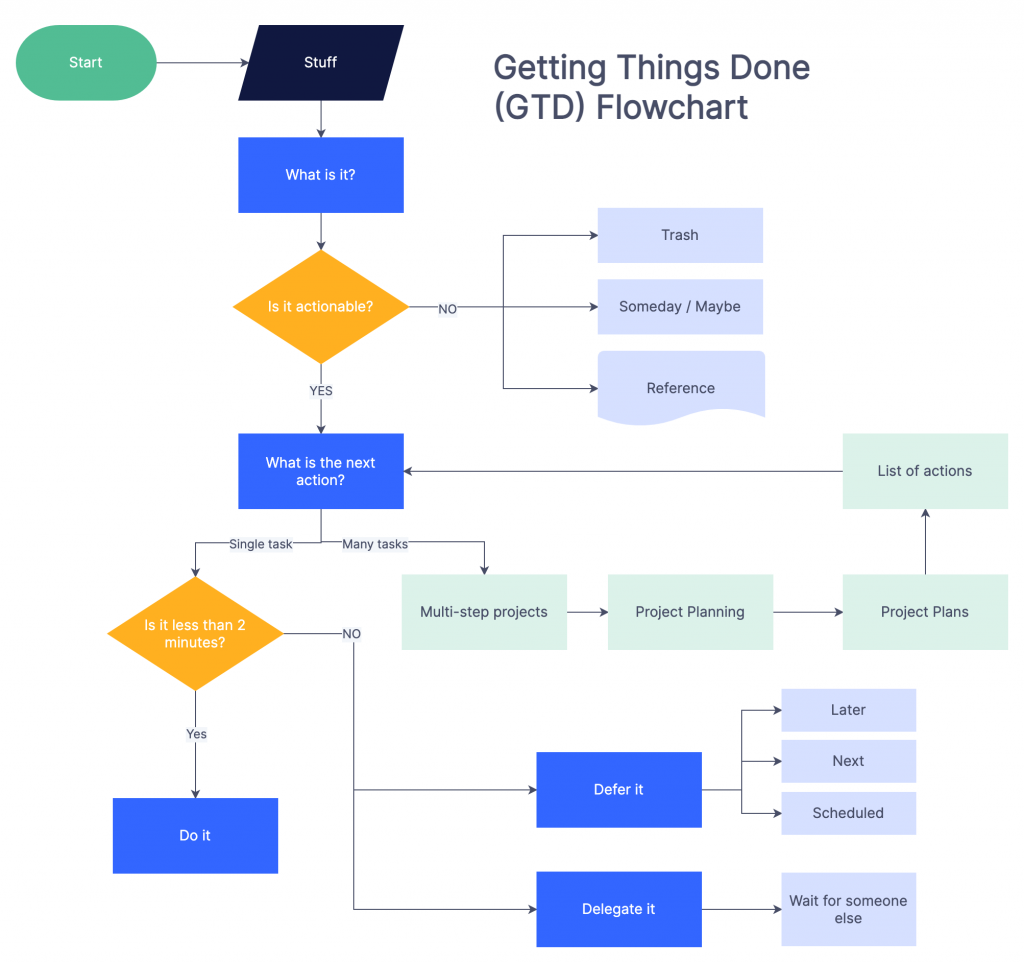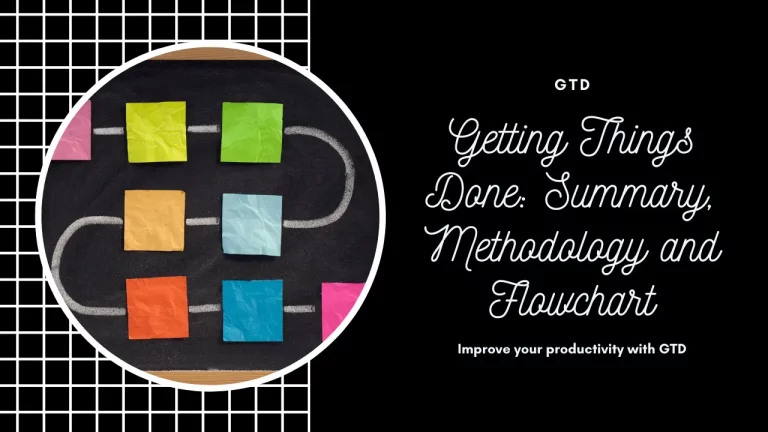Are you feeling swamped with an endless to-do list, wondering if 24 hours is enough to complete it? If so, you’re not alone. A study by the Harris Poll for the American Psychological Association in 2020 highlighted that over half of Americans felt buried under tasks with little time to get to them. And in this digital age, it’s no surprise. Distractions are everywhere, and striking a work-life balance is easier said than done.
Thankfully, there’s a productivity methodology that will help you tackle all of your to-dos and other tasks on time. It’s known as GTD – Getting Things Done. This methodology is quite popular, as it frees the mind of people from the burden of remembering everything.
What is Getting Things Done (GTD)?
Put simply, the GTD methodology is a time management method that was developed by productivity consultant David Allen. It is designed to help individuals manage their tasks, responsibilities, and commitments more effectively. The GTD system is based on the idea of moving tasks and ideas out of the mind by recording them externally and then breaking them into actional work items.
The GTD Methodology
The GTD Methodology revolves around five core steps:
The GTD Methodology consists of five crucial steps that overall help the user become more productive, as they become free of all mental worries regarding getting things done on time. Below are the five steps required to use GTD methodology in the correct manner.
1. Capture
The first step of the GTD methodology is Capture. Start by simply collecting everything that captures your attention into a collection tool. Back in the day, recorders or physical inboxes were used, but now we’ve got tools for everything.
2. Clarify
The next step of GTD is to process what you’ve captured. Decide if each item is actionable. If it’s not, either discard it, incubate it for potential future action, or file it as a reference. Do it immediately if it is actionable and can be done in less than two minutes. If it takes longer, delegate it, or defer it to be scheduled later.
3. Organize
The third step of the GTD methodology is to put each item where it belongs. If a task is actionable, decide the following action required. If it’s a multi-step project, break it down into individual tasks. Organize tasks based on context (e.g., @computer, @phone, @office), priority, and deadline. You can also create lists of tasks on a specific day or within a specific week.
4. Reflect
The fourth step of the GTD methodology is to review and update your lists regularly. Daily, look over your following actions. Review your entire system every week, from your calendar to your waiting-for and project lists, ensuring that everything is current and capturing any new tasks or commitments. This “Weekly Review” is a cornerstone of the GTD system.
5. Engage
The final step of GTD is to choose tasks from your organized lists and get to work. With a clear sense of your commitments and priorities, you can confidently choose the following action that aligns with your goals and the context you’re in.
GTD methodology is tool-agnostic, and it can be implemented with pen and paper, digital tools, or both. Over the years, many software applications have been developed specifically to accommodate the GTD approach.
Benefits Of GTD Methodology
GTD ensures that everything occupying your mind is captured and processed in an external system; it aims to reduce stress and cognitive load, enabling you to focus more efficiently on the task at hand and ensure nothing slips through the cracks.
However, that is not the only benefit of GTD. Here are some more benefits of the GTD methodology that can be helpful in your future endeavors.
1. Reduction In Stress Levels
GTD promotes the idea of “mind like water,” suggesting that when your tasks are organised, your mind is free from the anxiety of remembering them. A study published in the Journal of Personality and Social Psychology titled The “Zeigarnik Effect” demonstrates that uncompleted tasks and unmet goals tend to pop into one’s mind, causing anxiety.
By providing a system to capture and organize tasks, GTD alleviates the stress these unfinished tasks can cause.
2. Increased Productivity and Efficiency
By focusing on “next actions” and categorizing tasks, GTD allows individuals to be more efficient with their time. In the book “Making Work Work,” the author Shola Richards cites that the GTD method effectively boosts productivity.
3. Enhanced Ability to Focus on the Present Moment
With tasks and projects externalized and organized, one can be more present in current tasks without distractions. David Allen, in his book “Getting Things Done,” frequently discusses the idea that with a trusted system in place, individuals can focus more fully on the task at hand.
4. Improved Organizational Skills
GTD offers a clear and structured system to organize tasks, projects, and commitments. A study published in the Journal of Vocational Behavior titled “Organizational skills and personal productivity” links organizational skills to personal productivity, suggesting methodologies like GTD can have tangible benefits.
5. Improved Decision Making
By clarifying tasks and breaking them down, GTD can aid in better decision-making. In his book, David Allen emphasizes the importance of the “clarify” stage in GTD, where one decides on the nature of tasks and their corresponding actions, aiding in more informed decision-making.
As it is seen, The GTD methodology seems to have proven to boost productivity, based on multiple research and stats. Another method of using GTD is by using flowcharts; a GTD (Getting Things Done) flowchart visually represents the process and steps involved in the GTD methodology.
GTD Flowcharts
Flowcharts are helpful because they provide a clear, visual structure to the GTD system, allowing users to understand at a glance how different elements interact and what steps to take next.

A GTD flowchart can be created using flowchart software, diagramming tools, or even drawn by hand. It typically includes boxes or shapes representing each step, with arrows indicating the flow of tasks and decisions between them.
Setting Up Your GTD Workspace
Now that we know everything about GTD, let’s learn how to use the GTD methodology to our advantage. Following the steps below can boost your productivity and prevent future work-related stress.
A Clear Desk Policy: Starting Fresh
A clutter-free desk is the cornerstone of an efficient workspace. When the table is clear, the mind tends to mirror that orderliness. This approach isn’t limited to just the physical space. Just as one keeps a desk tidy, the digital workspace should also be organized.
The Power of an Inbox Tray: Centralizing Your Tasks
Every piece of paper, be it a receipt, letter, or a quick handwritten note, needs a temporary home before it gets processed. That’s where the inbox tray comes in handy, as the go-to spot for unsorted things. It ensures that everything has a place, ensuring every essential task or document gets noticed.
Dedicated Spaces for Pending and Future Tasks: Mapping Out the Future
Having designated areas, whether physical folders or sections, in a task management tool helps organize tasks based on their urgency and relevance. This ensures a clear distinction between tasks needing immediate attention and those lined up for the future. By creating this structure, it becomes easier to prioritize and navigate through daily responsibilities.
Incorporating traditional organization methods and modern tools like Akiflow provides a holistic approach to productivity. It’s about ensuring that every tangible or digital task is appropriately placed in the workflow.
How Does GTD Fare Against Other Productivity Techniques?
Granted, the GTD methodology isn’t the only one in the game. There are several time management and productivity-focused techniques out there, such as the Pomodoro technique, the Eisenhower box, Time blocking, etc. Different techniques suit different people, so let’s look at how GTD fares against these techniques and how effective it is compared to the other techniques.
1. GTD vs. Pomodoro Technique
- GTD focuses on capturing all tasks and to-dos, processing them, and organising them into actionable items. It emphasises externalising tasks to clear the mind and facilitate focused work.
- The Pomodoro Technique, developed by Francesco Cirillo, emphasizes working in focused sprints (typically 25 minutes), called “pomodoros,” followed by short breaks. It’s a time-management technique that aims to improve focus and reduce burnout.
2. GTD vs. Eisenhower Box
- GTD is a comprehensive workflow system that encompasses all tasks, regardless of urgency or importance.
- Eisenhower Box, inspired by Dwight D. Eisenhower, categorizes tasks based on their urgency and importance. Tasks are divided into four quadrants, helping prioritize what needs immediate attention versus what can be scheduled, delegated, or eliminated.
3. GTD vs. Kanban
- GTD emphasizes individual task management, moving tasks through stages of capture, clarifying, organizing, reflecting, and engaging.
- Kanban is a visual method, often using boards and cards, to manage workflow. Tasks move from one column to the next (e.g., “To Do,” “In Progress,” “Done”). Originally from lean manufacturing, it’s been adapted for personal productivity and software development.
4. GTD vs. Time Blocking
- GTD focuses on listing tasks and determining their next actionable steps without necessarily allocating specific time slots for each.
- Time Blocking involves allocating specific blocks of time for specific activities throughout the day. It’s a way to structure one’s day and ensure that time is set aside for both tasks and breaks.
5. GTD vs. The ONE Thing
- GTD provides a system for managing all tasks, big or small.
- Based on the book by Gary Keller and Jay Papasan, The ONE Thing encourages focusing on the single most crucial task that will make everything else easier or unnecessary. It emphasizes prioritization and focus.
6. GTD vs. The 2-Minute-Rule
- While the 2-minute rule is a part of the GTD methodology (if something takes less than two minutes, do it now), it’s often cited as a standalone productivity tip.
- The 2-Minute Rule, in a broader sense, also means starting new habits in just two minutes to ensure they’re not daunting (e.g., “read for just two minutes”).
Each productivity method has its merits and is designed to address specific challenges. The best approach for an individual often depends on their personal preferences, the nature of their work, their strengths and weaknesses, and the specific challenges they face in managing time and tasks. Some people even combine elements from multiple methods to create a hybrid system that suits their needs best.
Getting Things Done With Akiflow
Akiflow is a task management and calendar application designed to centralize tasks, events, and notes. Its features and integrations can be particularly helpful for individuals who want to implement the GTD (Getting Things Done) methodology.
Here’s how Akiflow can assist in GTD:
1. Capture
- Akiflow allows you to quickly capture tasks, notes, or events through its interface.
- Integration with tools like email and messaging platforms ensures you can funnel tasks from various sources into one centralized location.
2. Clarify
- You can detail tasks, attach notes, and categorize them, making it easier to define what needs to be done next.
- The user-friendly interface helps in swiftly processing and deciding the actionability of a task.
3. Organize
- Akiflow lets you categorize tasks using tags, making it simple to create GTD-specific tags like “@office,” “@calls,” or “@errands.”
- With its calendar integration, you can schedule tasks for specific dates and times, catering to the GTD principle of deferring tasks.
4. Reflect
- The application provides an overview of all tasks, making it easy to review them on a daily or weekly basis.
- Calendar synchronization ensures you don’t miss out on time-specific actions or day-specific tasks.
5. Engage
- Akiflow’s intuitive layout helps users identify and act on tasks based on their context, energy levels, and available time.
- Notifications and reminders ensure you stay on track with your tasks and commitments.
6. Integrations and Prioritization
- Integrating with other tools and platforms, Akiflow reduces the friction of managing tasks across multiple applications by integrating with other tools and platforms. This seamless integration aligns well with GTD’s principle of having a centralized system to manage tasks and information.
- Akiflow lets you prioritize tasks, making it easier to discern which tasks to tackle first.
7. Search Functionality
- The robust search feature in Akiflow ensures that no task or information gets lost, aligning with the GTD principle of having a trustworthy system.
While Akiflow isn’t exclusively designed for GTD, its features align well with GTD principles. If you’re comfortable with the application’s interface and its way of organising tasks and information, it can be a potent tool to implement and maintain the GTD methodology. As always, the effectiveness of a tool largely depends on the user’s commitment to the system and consistent usage.
Remember that Akiflow can be helpful in both Time Boxing And Time Blocking as well.
Conclusion
The GTD (Getting Things Done) methodology offers a structured approach to productivity, aiming to reduce cognitive load and improve task management. While numerous tools and applications, including Akiflow, can facilitate the implementation of GTD principles, the ultimate success of the method hinges on individual commitment and consistency.
Akiflow’s features, ranging from task capture to integration capabilities, align well with GTD’s core tenets, making it a valuable asset for optimizing its productivity journey. In an era of information overload, tools and methodologies that streamline our tasks and enhance focus are not just valuable; they’re essential. By combining the structured approach of GTD with the capabilities of Akiflow, individuals can navigate their tasks more efficiently and effectively.

How To Manage Time Blindness
Explore five effective tactics to conquer time blindness, a common challenge affecting time perception and management. Learn practical strategies for enhancing productivity and achieving a more organized, time-conscious lifestyle.

Dawn of Success: Crafting Effective Morning Rituals
Explore the transformative power of morning rituals in ‘Dawn of Success., and discover how effective morning routines can boost productivity, enhance well-being, and set the stage for daily achievements

12 Best Google Calendar Alternatives
Explore the top 12 Google Calendar alternatives to boost your productivity and streamline your scheduling. Check the diverse options catering to different needs and find the perfect calendar app for you.

